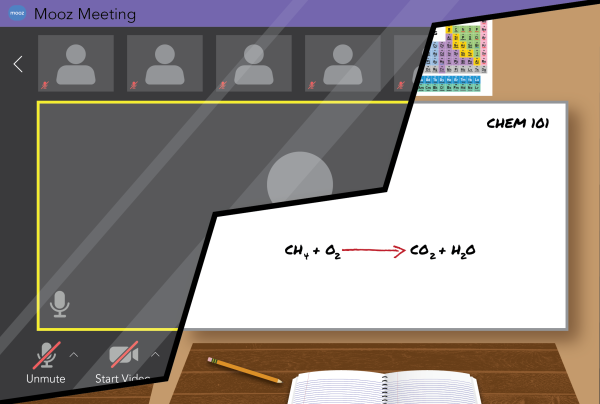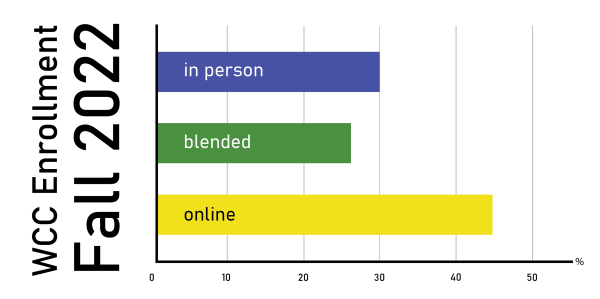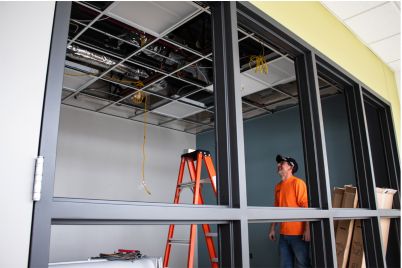
Laura Chodoroff | Washtenaw Voice
By Grace Crandall
Staff Writer
Several years ago, some had never heard of it. Now it seems difficult to imagine a world without it. Zoom has become a feature in nearly every school across the country, used by grade schools and colleges alike. The video chat company’s stock went up 400% by the end of 2020, proving its major influence during the COVID-19 pandemic.
Three years later, the influence of video chat is still reflected in schools. If not Zoom, then Google Hangouts or Microsoft Teams provide a virtual link to the classroom. This leaves many wondering if video chats will become a permanent feature of the average student’s school experience.
But this type of question was raised before the pandemic.
Online learning has become a prominent feature in the last decade, providing a flexible option for those with busy schedules. WCC has offered what it calls Distance Learning (DL) since the 2010s.
Distance learning courses are asynchronous, in which individual students plan when they will work on course material. In Winter 2019, 19.8% of WCC’s courses were offered in the DL mode, according to WCC enrollment records.
Unlike DL courses, WCC’s synchronous courses, implemented via Zoom, have certain meeting times in which a student must be present to “attend” the class. These synchronous courses, also known as virtual courses, are what began during the pandemic.
The COVID-19 pandemic temporarily shut down the campus, taking all classes online. Faculty and students alike faced an adjustment to learning online, whether that took the form of asynchronous or synchronous.
“Everyone was at a different place in terms of technology,” said Julie Kissel, English professor and president of the faculty union at WCC. “We did what we had to do at that time. But when given the opportunity, having some classes on campus and some classes virtually, you…pick the best approach that fits for that skill.”
Some classes returned to campus in Fall 2020 out of necessity, according to Kissel. However, this was a small percentage; 15% of all classes were in-person, with 32.9 % offered in DL. Additionally that semester, virtual classes were introduced, constituting 52.1% of all classes offered that semester.
This was a great change from one year prior, when 79.3% of classes were offered in-person, and the world of Zoom did not exist for WCC.
Since the height of the pandemic, the number of virtual classes has slowly dropped each semester. More recently, 18.7% of classes had a virtual option for Fall 2022 enrollment. With this yearly decline, the future of virtual courses is in question.
“There will be a use for virtual courses that remains,” said Kissel. “The ability to have office hours virtually is important. Those are things that will forever change, but I think we’ll go back to more classes face-to-face or fully online (DL), and that virtual will be a special case (in the future).”
Similarly, WCC’s provost Linda Blakey commented on the shift in course offering, and its dependence upon student demand.
“We’ll see how the next few semesters go. I think we’ll continue to offer virtual classes. But it’s based on meeting student needs,” said Blakey.
Determining course offering and selection includes many factors, according to Blakey. WCC breaks down enrollment into three categories: percentage of students taking in-person classes only, those taking both in-person and online classes,and those taking online classes only. The breakdown does not differentiate DL learning from virtual learning, however.
For Fall 2022, student enrollment for only in-person courses was 30%. Combination of in-person and online learning made up 26%, and only online made up the remaining 44%.

Laura Chodoroff | Washtenaw Voice
It may seem as though students prefer taking online classes based on the enrollment statistics, but Blakey said this was not necessarily the case. Oftentimes, faculty is driving the selection process. Students who prefer in-person learning may choose an online course based on its instructor.
“The instructor selection trumps the mode selection,” said Blakey. “What’s difficult is that that’s not an indicator that the student wants an online class.”
.There is a way, however, for students to provide feedback for their enrollment process. On WCC’s main website, students can go to the WCC gateway, and click “view classes”. From there, a question pops up, asking if students are finding the classes in the time and format they want. Blakey strongly encourages students to submit their feedback as soon as possible.
“The earlier the better,” said Blakey. “If we can get earlier feedback, we’ll have a better chance at adding the section and having enough time for students to enroll and have faculty to teach it.”


